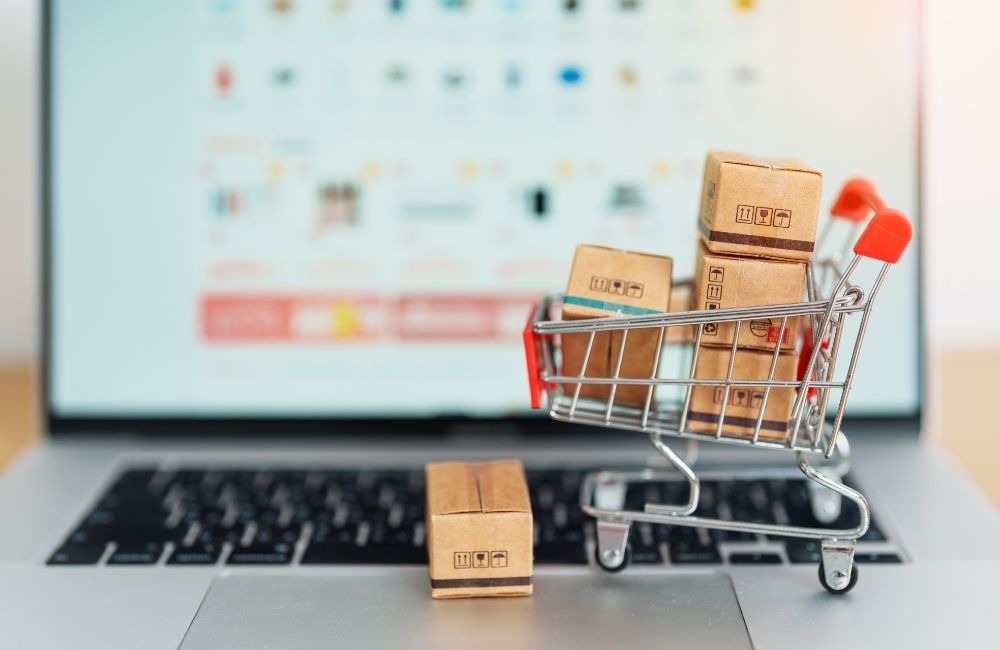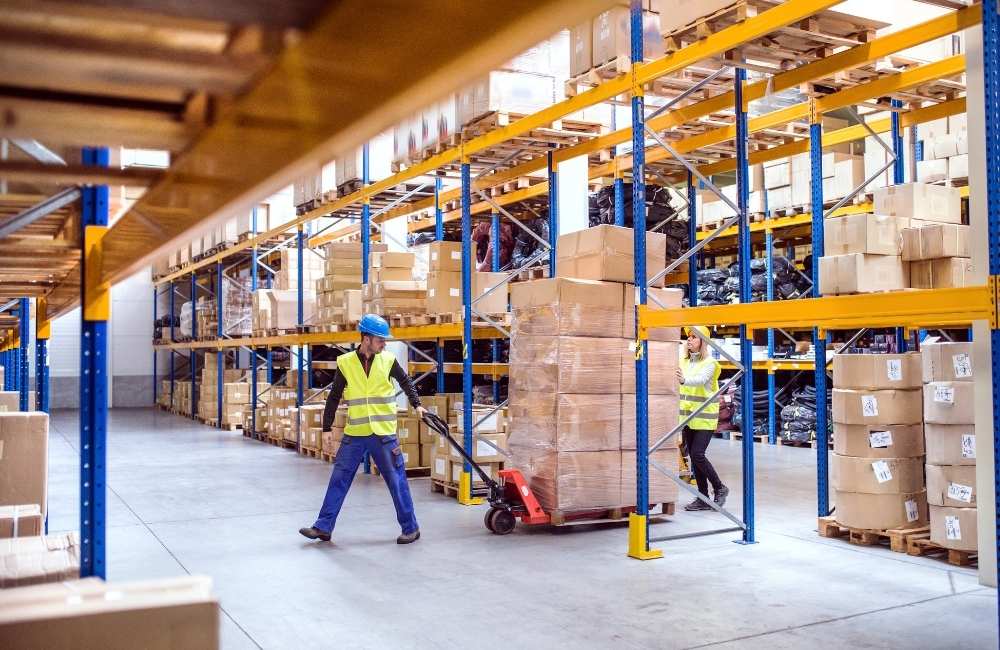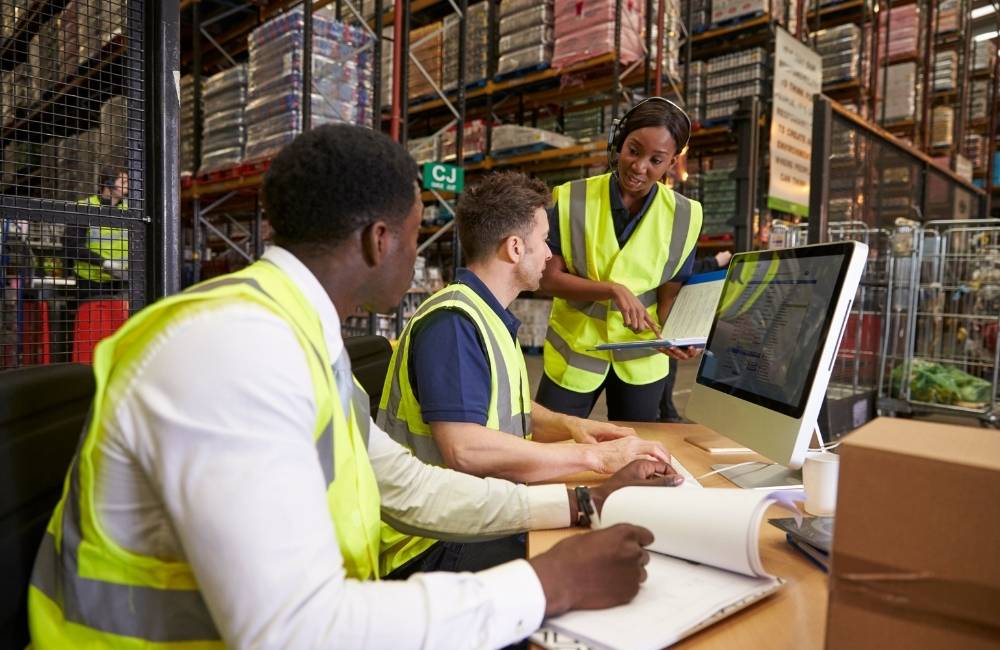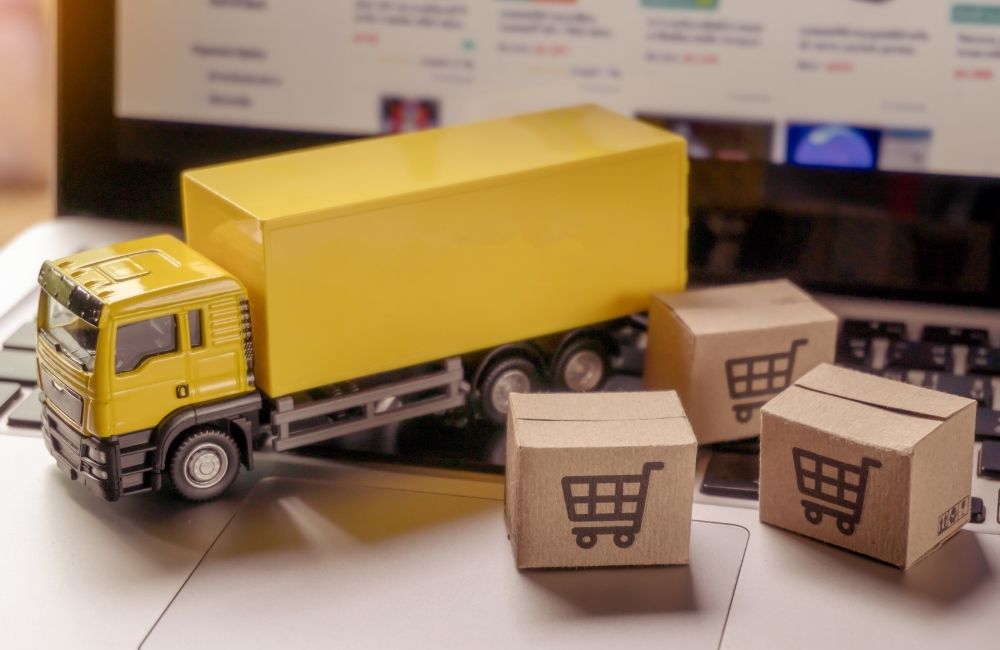E-commerce logistics plays a critical role in the success of online businesses. With customer expectations higher than ever, fast and efficient shipping is already a necessity. Companies must optimize logistics processes to keep up with demand, minimize costs, and improve customer satisfaction. From inventory management to last-mile delivery, streamlining operations ensures that orders reach customers quickly and accurately.
Here are the key strategies for improving e-commerce logistics and how businesses can enhance New York e-commerce fulfillment, streamline online store logistics in NYC, and improve inventory and order management for e-commerce to stay competitive in today’s fast-paced market.
Table of Contents
Key Takeaways
✔ Use real-time tracking, automation, and demand forecasting to prevent stock issues and improve order accuracy.
✔ Implement AI-driven sorting, robotic picking, and RFID scanning to speed up fulfillment and reduce human error.
✔ Select between in-house fulfillment, 3PL services, or dropshipping based on business size and growth plans.
✔ Utilize local distribution hubs, route optimization, and multiple carriers to enhance delivery speed and efficiency.
✔ Adopt cloud-based logistics software, IoT tracking, and AI analytics for real-time monitoring and disruption management.
✔ Negotiate better carrier rates, optimize packaging, and strategically locate fulfillment centers to cut costs.
✔ Use eco-friendly packaging, optimize delivery routes, and partner with carbon-neutral carriers to reduce environmental impact.
✔ Offer clear return policies, automate tracking, and streamline restocking to enhance customer satisfaction and minimize losses.
What Are the Challenges in E-commerce Logistics?
E-commerce logistics involves the end-to-end process of storing, managing, and delivering goods from an online store to customers. It encompasses inventory and order management for e-commerce, warehousing, shipping, and returns processing. While efficient logistics improve customer satisfaction and profitability, many companies face challenges that disrupt operations, leading to delays, increased costs, and dissatisfied customers. Identifying and addressing these challenges is crucial for maintaining a competitive edge in the rapidly growing e-commerce market.
1. Inventory Mismanagement
Managing inventory effectively is one of the biggest hurdles in e-commerce logistics. Businesses often struggle with:
- Overstocking – Leads to high storage costs, tying up capital in excess inventory that may not sell quickly. This issue is especially problematic for businesses with perishable or seasonal items.
- Understocking – Results in stockouts, causing lost sales and customer frustration. If a business frequently runs out of popular products, customers may switch to competitors, reducing brand loyalty.
- Inaccurate Inventory Tracking – Without real-time tracking, businesses risk overselling or failing to meet demand. This is particularly challenging for companies selling across multiple online platforms.
- Inefficient Warehouse Organization – Poorly structured storage systems slow down order fulfillment, increasing labor costs and errors. An optimized warehouse layout speeds up picking and packing, improving efficiency.
2. Slow Order Processing
E-commerce customers expect fast shipping, and delays in order fulfillment can lead to negative reviews and lost sales. The primary causes of slow order processing include:
- Manual Picking and Packing – A reliance on manual labor without automated systems slows down operations, increasing the risk of errors.
- Inefficient Order Prioritization – Without a proper system, businesses struggle to manage high-priority or expedited orders efficiently.
- Lack of Real-Time Order Tracking – Without instant updates, businesses cannot accurately monitor order progress, leading to delays in fulfillment.
- Limited Warehouse Staff – Not having enough personnel to process orders quickly during peak shopping seasons, such as holidays, results in bottlenecks and longer processing times.
3. High Shipping Costs
Rising transportation expenses are one of the most significant cost drivers in e-commerce logistics. Businesses face several cost-related challenges, including:
- Fluctuating Carrier Rates – Fuel prices, labor costs, and peak-season surcharges can lead to unpredictable shipping expenses.
- Dimensional Weight Pricing – Many carriers calculate shipping costs based on package dimensions rather than actual weight, increasing costs for bulky but lightweight items.
- International Shipping Complexities – Duties, tariffs, and customs regulations add costs and cause delays in cross-border shipping.
- Inefficient Packaging – Poorly optimized packaging increases shipping costs and results in wasted space, reducing the number of packages that can be shipped in one trip.
4. Last-Mile Delivery Issues
The final stage of order fulfillment—getting the package from a distribution hub to the customer—is often the most expensive and challenging. Common issues include:
- Traffic and Route Inefficiencies – Urban congestion and poor route planning result in delivery delays.
- Failed Deliveries – Customers not being home, incorrect addresses or delivery refusals create inefficiencies and additional costs for reattempts.
- Limited Carrier Availability – Some areas have fewer carrier options, leading to slower delivery times and higher fees.
- High Expectations for Same-Day or Next-Day Delivery – Customers demand faster delivery times, putting pressure on businesses to meet tight deadlines.
5. Returns Handling (Reverse Logistics)
Efficient returns management is just as important as outbound shipping. A poor reverse logistics system leads to increased costs, lost revenue, and dissatisfied customers. Challenges include:
- Complicated Return Policies – If the return process is unclear or inconvenient, customers may hesitate to make purchases.
- High Processing Costs – Inspecting, restocking, and reselling returned goods require time and resources, increasing expenses.
- Fraudulent Returns – Some customers abuse return policies by sending back used or damaged items.
- Inventory Disruptions – Poor returns handling can result in unsellable stock or delayed restocking of returned items.

8 Key Strategies for Fast and Efficient E-commerce Logistics
Implementing the right logistics strategies ensures smooth operations and enhances customer satisfaction. Businesses looking to improve online store logistics in NYC and beyond should focus on the following key tactics:
1. Optimize Inventory Management
Managing inventory efficiently is the foundation of streamlined e-commerce logistics. Poor inventory control leads to stock shortages, overstocking, and fulfillment delays. Businesses should implement:
- Real-time inventory tracking – Prevents discrepancies and provides accurate stock visibility. It enables businesses to track product movement in real-time, reducing the risk of misplaced or lost items.
- Automated stock monitoring – Reduces manual errors and optimizes replenishment. Automated systems send alerts for low stock levels, ensuring timely restocking before stockouts occur.
- Demand forecasting tools – Uses data analytics to anticipate trends and manage stock levels effectively. These tools help businesses plan ahead for peak seasons and sudden demand fluctuations.
- Multi-channel synchronization – Ensures inventory data remains consistent across different platforms. It prevents overselling by updating inventory levels instantly across all marketplaces and sales channels.
- Advanced inventory and order management for e-commerce software – Helps businesses track stock, automate reorders, and prevent costly supply chain disruptions. This software also integrates with fulfillment centers, improving accuracy and efficiency in order processing.
2. Leverage Automation
Automation improves speed, accuracy, and efficiency in e-commerce logistics, making it essential for scalable operations. Businesses can benefit from:
- AI-driven sorting systems – Speeds up the order fulfillment process. These systems classify packages based on delivery location, minimizing sorting errors and speeding up dispatch.
- Robotic picking and packing – Reduces labor costs and increases order accuracy. Robots can handle repetitive tasks efficiently, freeing up human workers for more complex operations.
- Barcode and RFID scanning – Enhances inventory tracking and minimizes errors. This technology ensures each item is correctly labeled and tracked from storage to final delivery.
- Automated warehouse systems – Helps optimize storage and retrieval of products. Smart shelving and robotic retrieval systems maximize space utilization and reduce fulfillment time.
- New York e-commerce fulfillment centers – Utilize automation to process high order volumes quickly, ensuring faster delivery times and improved efficiency. These centers rely on AI-driven logistics to manage fluctuating demand efficiently.
3. Choose the Right Fulfillment Model
The right fulfillment model depends on business size, order volume, and long-term growth strategy. Companies must evaluate the following options:
- In-house Fulfillment – Best for small businesses managing their own storage and shipping. This model gives businesses direct control over their fulfillment operations but requires warehouse space and staff.
- Third-Party Logistics (3PL) – Helps companies scale by outsourcing warehousing, packing, and shipping. A 3PL provider can offer advanced technology, streamlined operations, and access to a vast logistics network.
- Dropshipping – Allows businesses to sell products without handling inventory, reducing upfront costs. Suppliers manage product storage and shipping, eliminating the need for businesses to maintain a physical inventory.
- New York e-commerce fulfillment providers – Allow businesses to streamline shipping while reducing operational burdens. These fulfillment centers strategically position warehouses near major shipping hubs to speed up deliveries.
4. Streamline Last-Mile Delivery
Last-mile delivery is often the most expensive and time-consuming part of e-commerce logistics. Delays and inefficiencies negatively impact customer satisfaction. Research indicates that online shoppers worldwide prioritize faster delivery (48%), affordable shipping (43%), and accurate delivery time information (39%). Businesses that optimize last-mile logistics to meet these expectations can significantly enhance customer satisfaction and loyalty. To optimize last-mile delivery, businesses should:
- Use local distribution hubs – Shortens delivery distances and reduces transit time. These hubs allow businesses to store inventory closer to customers, enabling faster same-day or next-day deliveries.
- Partner with multiple carriers – Offers more delivery options and flexibility. A diversified carrier network reduces reliance on a single shipping provider and ensures cost-efficient shipping.
- Implement route optimization software – Helps reduce delays and fuel costs. AI-powered logistics platforms analyze real-time traffic patterns to determine the fastest delivery routes.
- Provide same-day or next-day delivery – A must for competitive online store logistics in NYC. Businesses that offer faster delivery options gain an edge over competitors and improve customer retention.
- Businesses that improve last-mile logistics – See fewer delays, lower costs, and better customer satisfaction. Optimizing this stage of fulfillment ensures higher order completion rates and reduces refund requests due to late deliveries.
5. Enhance Supply Chain Visibility
Supply chain transparency helps businesses anticipate disruptions and optimize shipping strategies. To improve visibility, companies should:
- Adopt cloud-based logistics software – Provides real-time tracking and automated reporting. These platforms allow businesses to monitor shipments, inventory, and warehouse operations from a single dashboard.
- Use IoT-enabled tracking devices – Monitors shipments and alerts businesses to delays. IoT sensors help businesses track environmental conditions like temperature and humidity for sensitive shipments.
- Integrate warehouse management systems (WMS) – Synchronizes inventory, fulfillment, and shipping operations. A WMS improves warehouse efficiency by automating stock allocation, reducing picking errors, and improving storage management.
- Leverage AI-driven predictive analytics – Helps anticipate demand and manage supply chain disruptions. Machine learning algorithms identify supply chain risks before they impact fulfillment operations.
- Enhanced visibility – Allows for faster response times and better decision-making in New York e-commerce fulfillment operations. Businesses can proactively manage supply chain disruptions and prevent costly delays.
6. Reduce Shipping Costs Without Sacrificing Speed
Shipping costs significantly impact profitability. Businesses must find ways to reduce expenses while maintaining fast delivery. Lower shipping expenses play a crucial role in fueling the growth of the e-commerce logistics market. As businesses optimize logistics and reduce transportation costs, they can offer competitive pricing and faster delivery, improving customer satisfaction and market competitiveness. Strategies include:
- Negotiating lower rates with multiple carriers – Ensures cost-effective shipping options. Comparing shipping rates from multiple providers helps secure better discounts and minimize transportation costs.
- Using dynamic pricing models – Balances speed and affordability based on customer preferences. Businesses can offer tiered shipping options, letting customers choose between cost savings and expedited shipping.
- Optimizing packaging size and weight – Reduces shipping fees by minimizing dimensional weight charges. Custom-sized packaging reduces wasted space, lowering shipping costs and improving package protection.
- Implementing zone-based shipping strategies – Assigns fulfillment centers closer to key customer locations. This strategy reduces shipping zones and ensures faster, more affordable deliveries.
- Refining shipping strategies – Keeps costs low while ensuring online store logistics in NYC remain efficient. Businesses that streamline logistics can provide competitive pricing without sacrificing delivery speed.
7. Implement Sustainable Logistics Practices
Sustainability is becoming a priority in e-commerce logistics, with consumers demanding eco-friendly solutions. Businesses should adopt:
- Eco-friendly packaging – Reduces waste and appeals to environmentally conscious customers. Biodegradable and recyclable materials lower environmental impact while maintaining product protection.
- Optimized delivery routes – Lowers fuel consumption and emissions. AI-driven logistics software ensures delivery vehicles take the shortest, most efficient routes.
- Carbon-neutral shipping options – Offsets environmental impact through sustainability programs. Many shipping carriers offer carbon offset programs that help businesses minimize their carbon footprint.
- Recyclable or biodegradable shipping materials – Minimizes plastic waste in packaging. Using compostable mailers and reducing excess packaging materials contribute to greener logistics.
- Sustainable logistics – Not only helps the environment but also enhances brand reputation and customer loyalty. Consumers prefer eco-friendly brands, making sustainability a competitive advantage.
8. Improve Returns Management
An efficient returns process is essential for customer retention. Poor returns handling can result in revenue loss and negative reviews. To improve inventory and order management for e-commerce, businesses should:
- Provide clear return policies – Sets customer expectations and reduces disputes. A well-defined returns policy helps customers understand the process and minimizes confusion.
- Use automated return tracking – Enhances transparency for both businesses and customers. Digital return portals allow customers to initiate returns seamlessly and track progress.
- Streamline restocking and resale processes – Prevents unnecessary losses from returned items. Reselling lightly used or refurbished products reduces inventory waste and improves profitability.
- Offer hassle-free return options – Encourages repeat purchases and builds trust. A simple and convenient returns process increases customer confidence in future purchases.
- A strong returns system – Improves New York e-commerce fulfillment, ensuring customers remain satisfied even when sending items back. Businesses that handle returns efficiently build long-term customer relationships and reduce churn.

Why Partner with a Trusted 3PL Company for Seamless Logistics
A third-party logistics (3PL) provider plays a crucial role in improving e-commerce logistics efficiency. Businesses seeking to streamline New York e-commerce fulfillment operations often turn to 3PL providers to handle warehousing, order processing, and shipping. By outsourcing logistics, companies can reduce operational burdens, increase scalability, and enhance the overall customer experience.
Benefits of Working with a 3PL Partner
A 3PL provider offers numerous advantages that help businesses streamline online store logistics in NYC while focusing on core operations. Key benefits include:
- Scalability – 3PLs handle increased order volumes during peak seasons. Businesses can expand without worrying about warehouse space, staffing, or delays in fulfillment. This flexibility ensures that seasonal spikes and sudden demand surges do not disrupt operations.
- Faster Shipping – Established logistics networks ensure quicker deliveries. A well-connected 3PL has multiple distribution centers, allowing for New York e-commerce fulfillment that reduces transit times and enhances customer satisfaction.
- Cost Savings – Businesses avoid high warehouse rental and labor costs. By outsourcing logistics, companies eliminate the need for owning or leasing storage facilities, investing in equipment, and hiring fulfillment staff. This leads to significant long-term savings.
- Technology Integration – 3PLs use advanced inventory and order management for e-commerce systems for real-time tracking. These systems provide transparency, allowing businesses to monitor inventory levels, shipment statuses, and order fulfillment performance without manual intervention.
- Expertise and Compliance – A 3PL ensures businesses meet regulatory requirements and industry standards. They handle customs documentation, freight classification, and product-specific compliance, reducing the risk of shipping delays due to regulatory issues.
- Better Returns Management – A 3PL can optimize reverse logistics, streamlining returns processing. This ensures a smoother customer experience while reducing losses from returned or damaged goods.
- Increased Focus on Business Growth – By outsourcing logistics, businesses can focus on expansion, product development, and marketing instead of supply chain management. This allows e-commerce brands to stay competitive without being overwhelmed by fulfillment challenges.
How to Choose the Right 3PL Company
Selecting a 3PL partner requires careful evaluation. Businesses should consider the following factors to ensure a successful partnership:
- Experience in E-commerce Logistics – A proven track record in handling e-commerce logistics is essential. A 3PL that understands fulfillment challenges, consumer expectations, and industry trends will offer better solutions tailored to online retailers.
- Warehouse Locations – Facilities near key customer bases, such as New York e-commerce fulfillment centers, ensure faster delivery. Strategically positioned warehouses reduce shipping distances, enabling same-day and next-day delivery options.
- Technology and Automation – The ability to integrate with existing inventory and order management for e-commerce platforms is critical. Businesses should choose a 3PL with advanced warehouse automation, order tracking software, and AI-driven logistics tools to optimize efficiency.
- Flexible Shipping Options – Multiple carrier partnerships provide cost-effective shipping solutions. A reliable 3PL should offer various shipping methods, including ground, expedited, and international shipping, to accommodate different customer needs.
- Customer Support and Responsiveness – A 3PL should offer excellent customer service, with clear communication and quick issue resolution. Reliable partners provide 24/7 support, proactive updates, and dedicated account managers to ensure seamless operations.
- Customization and Specialization – Some 3PLs specialize in specific industries, such as fashion, electronics, or perishable goods. Choosing a provider with expertise in a business’s niche ensures better handling of product-specific logistics requirements.
- Scalability and Growth Potential – The 3PL should be able to scale as the business expands. Partnering with a provider that can handle increased order volumes, international shipping, and evolving fulfillment needs ensures long-term success.
- Transparent Pricing Structure – Businesses should review pricing models carefully to avoid hidden fees. Some 3PLs charge per order, per unit stored, or by weight, so understanding cost breakdowns helps businesses make informed financial decisions.
Frequently Asked Questions
What is last-mile delivery in e-commerce?
Last-mile delivery refers to the final step of the delivery process where goods are transported from a distribution hub to the end customer. It is crucial for ensuring fast, reliable shipping and meeting customer expectations. Optimizing last-mile logistics can reduce delays, lower costs, and improve customer satisfaction.
How does e-commerce logistics impact supply chain management?
E-commerce logistics integrates key supply chain processes such as inventory control, warehousing, and transportation. Efficient logistics streamline operations, reduce delays, and improve order fulfillment accuracy. A well-optimized logistics system enhances overall supply chain resilience and customer satisfaction.
What are the environmental impacts of e-commerce logistics?
E-commerce logistics contributes to increased carbon emissions from transportation and excessive packaging waste. Businesses can mitigate these effects by using eco-friendly packaging, optimizing delivery routes, and adopting carbon-neutral shipping options. Implementing sustainable logistics practices benefits both the environment and brand reputation.
What are the biggest trends shaping the future of e-commerce logistics?
Emerging trends include drone deliveries, AI-powered warehouse automation, and blockchain for secure, transparent tracking. Same-day and next-day delivery services are expanding as businesses invest in faster, more efficient fulfillment strategies. Companies leveraging these innovations improve operational efficiency and gain a competitive advantage.
What is the role of technology in e-commerce logistics?
Technology enhances e-commerce logistics through automation, real-time tracking, and predictive analytics. AI-driven sorting systems, IoT-enabled tracking devices, and cloud-based inventory management improve efficiency and reduce human errors. Businesses that integrate advanced logistics technology can streamline operations and provide better customer experiences.

Partner with 3PL Logistics by Best for Seamless E-commerce Logistics in New York City!
Efficient e-commerce logistics are vital for business success in New York City. 3PL Logistics by Best, located in NYC, offers comprehensive third-party logistics services tailored to meet your business needs. Our expertise in freight brokerage, warehouse management, and inventory optimization ensures streamlined operations and enhanced customer satisfaction. By partnering with 3PL Logistics by Best, New York City businesses can benefit from scalable solutions that adapt to market demands. Our advanced technology and customer-centric approach make us a trusted logistics partner in NYC.
Contact 3PL Logistics by Best in New York City today to elevate your e-commerce logistics and drive business growth!

